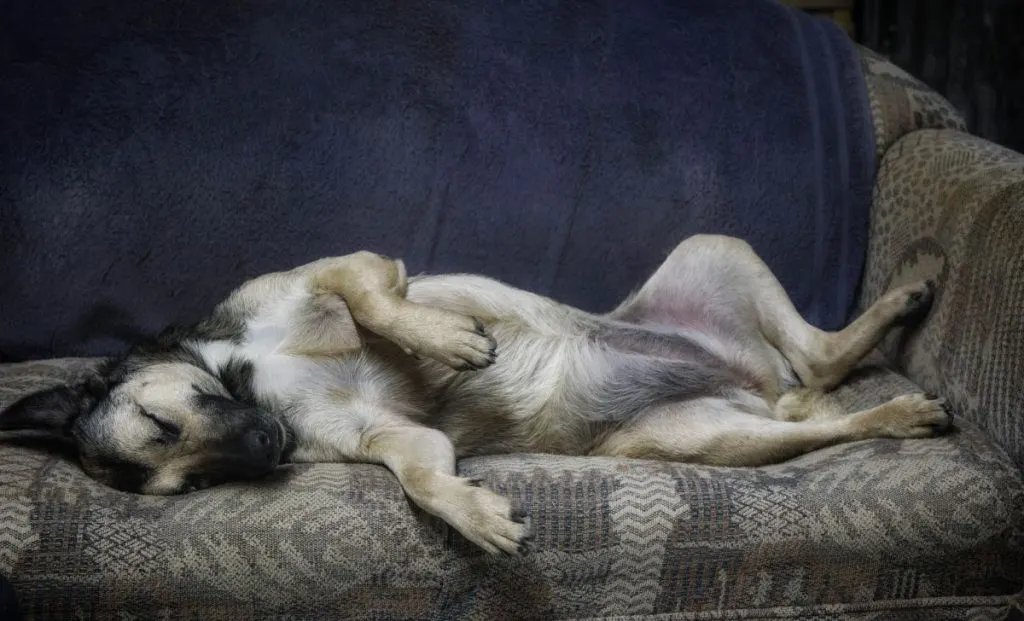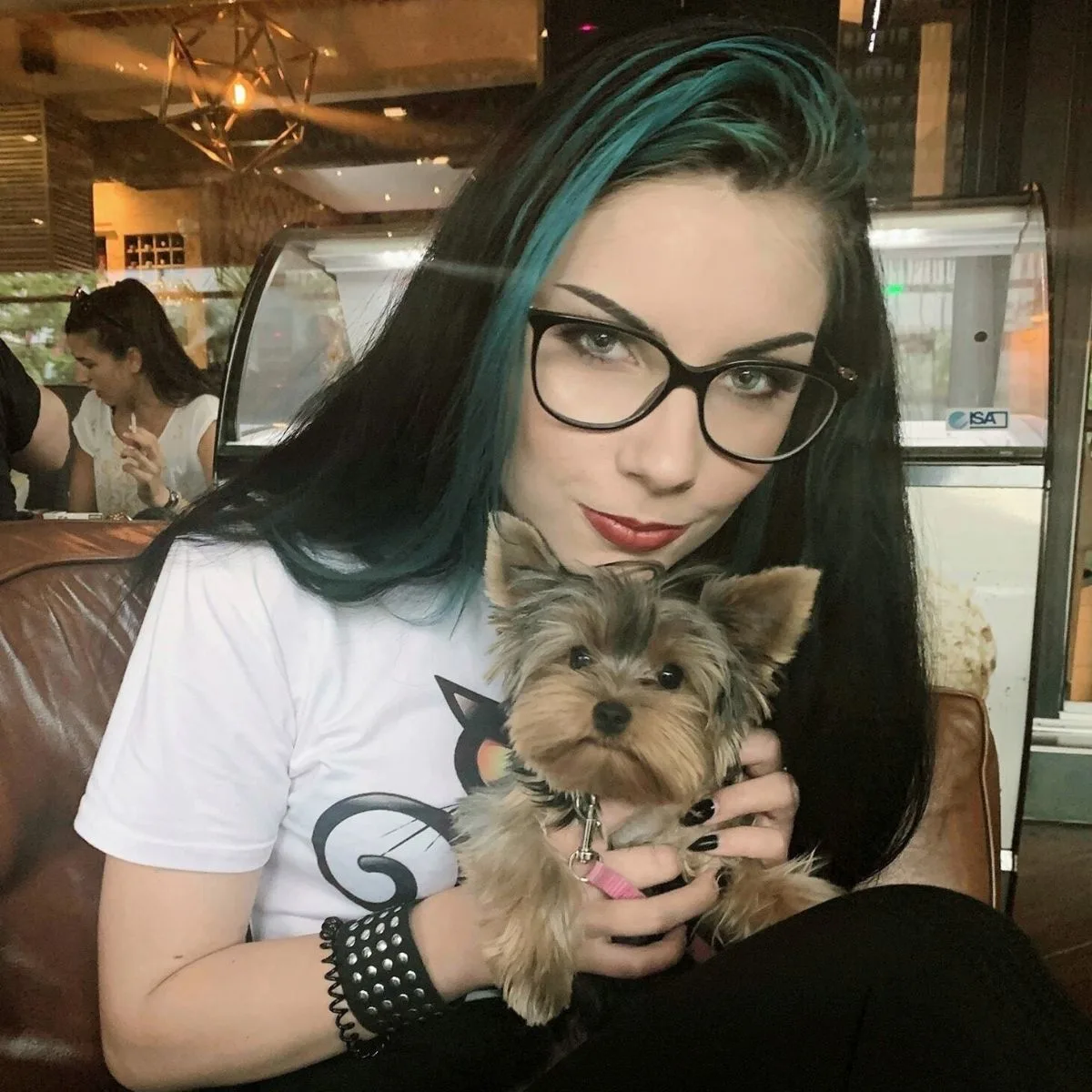All dog owners have seen their dogs twitch and whine in sleep. Does this mean what we think it means? Do dogs dream, or is this just some instinctive movement?
We love to give our beloved pets human characteristics as we think this helps us get closer to them. However, we aren’t always right, and many times, we even make mistakes in dog training or socialization as we’ve misinterpreted our pooch’s behavior.
Well, I have some good news, and that is that we aren’t wrong about this topic. Dogs really do dream! Some can even experience nightmares!
Let’s learn all we can about this interesting topic, and see what our furry companions might be dreaming about.
Can Dogs Dream?

Humans aren’t the only creatures who experience dreams. Quite the opposite—scientists believe that all vertebrates dream. In fact, some think that almost all living beings, including fruit flies, experience some type of dream.
Considering that dogs can spend half a day napping on our couch, it would be wrong to even assume they don’t dream at all!
You have probably noticed your dog twitching or moving his feet at certain points when he’s sleeping. Maybe he whined or even jumped in sleep! All of these activities are quite similar to what humans do during the night, and they tell us that our dog is currently in his own dreamland.
The Science Behind Dog Dreams
Just like humans, all animals, including dogs, go through different sleep cycles. This includes periods of wakefulness, periods of slow wave sleep, and finally, periods of rapid eye movement sleep, also known as REM sleep.
REM is the period when vivid dreams happen, and it is believed to be connected with the part of the brain that stores memory.
As brain waves differ during the different stages of sleeping, scientists can track sleep cycles in animals using adequate equipment.
There is scientific evidence that animal brains are quite similar to humans, at least on a structural level.
The Massachusetts Institute of Technology did the most notable experiment on this topic on lab rats. They made rats run in the maze throughout the day and followed their brain waves. Then, they tracked brain waves when the rats were sleeping.
Rats’ brains lit in the same area during the REM stage and while they were running in the maze. This showed that their dreams were connected with daily activities.
Not only that, but the research was so precise that the scientists could guess exactly what part of the maze the rats were dreaming about!
As canines fall asleep, their breathing becomes deeper and regular—at first. The REM sleep stage usually starts some 20 minutes later, and this is when breath becomes irregular and shallow. This is also when the muscles might twitch.
The most noticeable part of the deeper stage of sleep is rapid eye movement under the eyelids. This is precisely why it’s called the rapid eye movement stage.
What Are Dreams?

Dreams are, essentially, images and scenes our mind makes during sleep.
During sleep, our consciousness and muscle movements are reduced, which helps us get rest.
Everything we dream about is just the product of our brain. While we might dream about seeing things, smelling, and hearing them, this isn’t really happening. These are simply the information our brain goes over at this time.
It isn’t yet entirely certain why do dogs and other living beings dream. Some theories include that dreams are just interpretations of random signals from the brain and body while we’re asleep. Others think they help the brain consolidate and process information gathered throughout the day.
Either way, dreams are an essential part of our subconsciousness.
How Are Dog Dreams Different From Humans’?
It is really different to give the right answer to this question.
As stated before, according to science, there aren’t that many differences between the way humans and animals such as dogs and cats dream.
Both humans and canines go through the same stages of the sleep cycle. Both can be easily awakened during the slow wave sleep stage, but waking up during the REM stage is much more challenging.
More importantly, both have comparable brain waves that help researchers understand the stage that the dog is currently in.
It is assumed that humans have longer dreams that are more complex than canine dreams. This doesn’t mean that dogs aren’t capable of having complex dreams. Rather, as their consciousness is slightly different than humans’, this likely affects dreams, as well.
However, this is only speculation. Until dogs find a way to tell us exactly what they dream, it’s impossible to know just how different their dreams are from ours.
What Are Dogs Dreaming About?

Unlike humans, dogs cannot just tell us what they are dreaming about. As such, the only things we know are the results of several pieces of research and guesses.
One such research included disabling the pons, a part of the brain stem that is involved in the control of sleep cycles and preventing the muscles from moving during sleep.
To put it simply, pons are the reason why you aren’t walking and talking in your sleep as if you were awake.
The results of the research and monitoring canine behavior while asleep have shown that dogs dream pretty much the same things as humans.
Dogs’ brains gather information while they are awake. Then, this information is shown in the shapes of dreams while our subconsciousness is loose.
So, it is entirely possible that your dog is dreaming about chasing rabbits or running away from other dogs.
If you see him smacking his lips, chances are he is dreaming of his favorite treat. Maybe he is even dreaming of the day he ate a bee or playing with his favorite squeaky toy!
How Often Do Dogs Dream?

Just like humans, dogs dream in different frequencies, and some might dream more than others.
It is believed that puppies and senior dogs dream more often than adult canines. However, this might not be true, as pons are simply less activated in young and old canines, so maybe they are just being more expressive during dreams.
At the same time, puppies do process plenty of new information, so it is possible their brains are more active during dreaming. The same happens with human infants, who also tend to have more vivid dreams than adults
It also seems that smaller dog breeds dream more frequently than larger dogs. However, their dreams are often short and not as vivid.
Certain dream experiments have also shown that certain dog breeds have longer dreams than others. The length of the dream seems to depend on the dog’s size. Smaller dogs dream shorter than large dogs.
For example, a Labrador Retriever will dream longer than a Toy Poodle or a Chihuahua.
Another factor that might affect the length of the dream is the length of the sleep. If your dog sleeps all day, he will likely spend more time dreaming than a dog that doesn’t sleep as much.
This is likely one of the reasons why many larger dog breeds will dream longer. As they are more active, they will have more new experiences throughout the day. Then, they’ll become really tired and sleep for a longer time to replenish all that lost energy.
Do Dogs Have Nightmares?
Most of us have seen our pooches whine and sleep run at least once. I personally have been awakened at least three times by my mixed breed’s large barks at night. Yes, he was asleep while barking, and no, there’s nothing I can do to stop this.
Due to such behaviors, it’s easy to suppose that our furry companions can have nightmares in a similar manner human beings do.
Don’t let this sadden or frighten you, though. Most of the time, your best friend will dream of an open field and favorite toys rather than scary things such as the pound.
If you suspect your pooch is having nightmares often, you might consider giving him a calming treat to help him calm the anxiety.
How To Tell A Dog Is Dreaming
Now that you know that dogs are, indeed, capable of dreaming, you might be wondering how you can know if your Fido is experiencing just that and when.
As dogs have different dream patterns, it’s impossible to say that your dog will dream at a certain point during the night. However, there will be a few telltale signs that will let you know that your pup is, indeed, dreaming.
Learning about this is important, not just to satisfy your curiosity but also for practical reasons. If you see your dog moving or twitching too much during sleep, you might need to contact your vet, as there is a chance your canine is suffering from a sleep disorder.
Eye Movements
As mentioned before, the most obvious signs of the REM phase are the eye movements. The eyes of your dog will be moving rapidly underneath the eyelids, and this will be noticeable just by closely observing your dog’s face.
Some dogs might sleep with their eyes open so that you can observe their movements with ease.
While these movements are partially due to brain waves, another cause is your dog ‘seeing’ the images in his dream. This is why many people would agree that rapid eye movements are a certain sign of dreaming, both in canines and in humans.
Twitching
Dogs can experience twitches, known as hypnic jerks or myoclonus, in sleep, especially at the slow wave sleep stage, but they can also occur in REM.
Twitching is typically the first thing we notice when we suspect our pups might be having a dream. However, they can also be a sign that our dog is just starting to fall asleep.
Quivering
Many dogs quiver or shake during their dreams, and this is another common behavior that can let dog owners know their pup is dreaming at that moment.
This is a movement of large muscles that is, essentially, your dog acting according to his dreams. It is an involuntary spasm.
Quivering can sometimes be confused with seizures. I’ll talk more about that in a bit, so keep on reading.
Vocalization
Some dogs can murmur, howl, whine, or even bark during dreams! Who knows what they are dreaming about, but I love to imagine my pooch is chasing rabbits or other wild animals with his wolf pack.
These vocalizations are pretty normal, and they are the equivalent of humans talking in their sleep.
If a dog is barking, this is usually a sign of a happy dream. On the other hand, a dog that’s whining might be having a scary dream and is feeling frightened. However, this is only an estimation as, once again, it’s impossible to know precisely what your dog is dreaming about.
Sleepwalking
Sleepwalking is yet another common and noticeable sign that your dog is having a dream.
It is entirely unconscious, and your pooch’s muscles are simply following his thoughts.
As such, don’t be angry if your dog wakes you up during the night as he jumps or even crashes onto things. He isn’t aware of this.
Also, quivering can be quite dangerous, as your pooch is risking hurting himself if the movements become too strong. The pup from the following video was lucky that he didn’t get seriously injured during his nighttime adventures!
Differences Between Dream Movements And Seizures
Certain dream movements are quite similar to convulsions or seizures, and many owners confuse the two, especially if the dog is known to have canine epilepsy or another condition that causes seizures. Fortunately, there are some differences that can help you.
Both dream movements and seizures originate in the brain. However, while seizures are the result of abnormal brain waves, dream movements are natural and aren’t harmful.
Both dog dreams and seizures can express themselves with muscle twitching and feet paddling, but the two appear quite differently.
Dreams produce gentle twitches that typically last for a short amount of time. On the other hand, seizures cause violent movements that can last up to several minutes. Also, during seizures, the limbs become stiff and rigid while they are relaxed in dream movements.
Sometimes, a dog might vet himself during seizures, so if you see this happening while your dog is asleep, you should take this as a warning sign.
Other differences can be noticed once the dog wakes. A dog that was simply dreaming will wake up and act as he always would, while a dog that had a seizure will behave confused, scared, and dazed.
Seizures can be life-threatening, especially if they appear often. If you suspect your dog is having convulsions, contact your veterinarian.
While there isn’t a cure for canine epilepsy, the condition can be managed with proper care and medication.
Should You Wake Up A Dog That Is Twitching?
When we see our pup twitching and whining, we immediately suppose he is having bad dreams – and we would be right quite often.
The instinctual reaction we have is to wake our dog up and stop the nightmare, hoping this will help him feel better. However, this isn’t a recommended course of action.
It isn’t easy to wake up a dog that’s in the deep sleep stage. They take some time to wake up, and until they do, they can be confused or scared.
If you touch your dog while he is dreaming of bad things, he might accidentally snap at you and bite or scratch you. This doesn’t mean your dog is aggressive – he is simply scared.
Of course, sometimes it’s hard to watch our dog trembling and twitching. If you really insist on waking your dog up, try calling his name gently. This can help him feel safe and secure.
Avoid touching your poop until you are certain he is entirely awake.
Not only do dogs dream, but they can have really scary nightmares. They can also experience happy dreams, and maybe even feel frustrated upon waking up.
Either way, this should give us a deep understanding of how complex dogs truly are.

Vanja’s passion for writing started at an early age, which is why she pursued Journalism as her college degree. She can research any topic and find all the information before you bat an eye, which is a great thing for her job but a terrible one for her husband.
Even as a young child, she fell in love with everything fluffy – but dogs have a special place in her heart due to her childhood companion, a Corgie named Archie.
Motivated by her experiences and driven by a desire to give back to her four-legged companions, she spends her free time volunteering at a local dog shelter.
